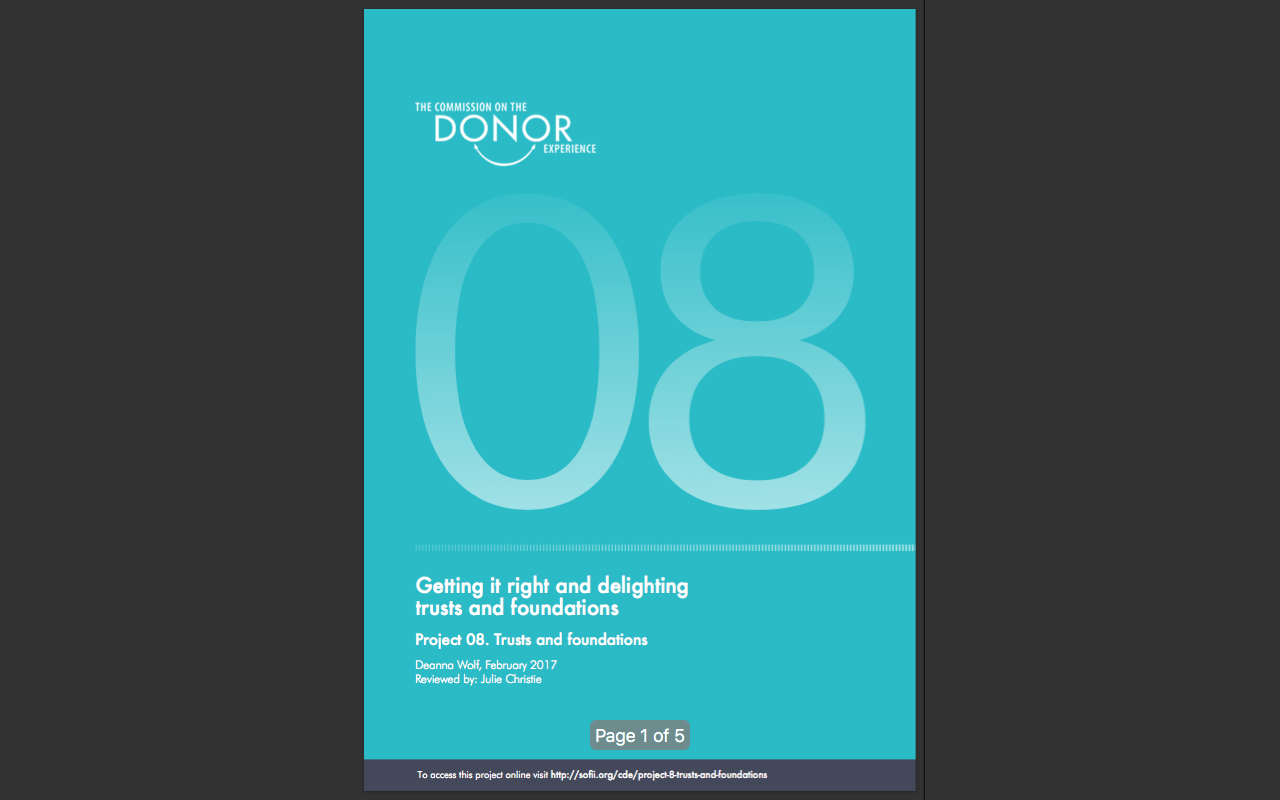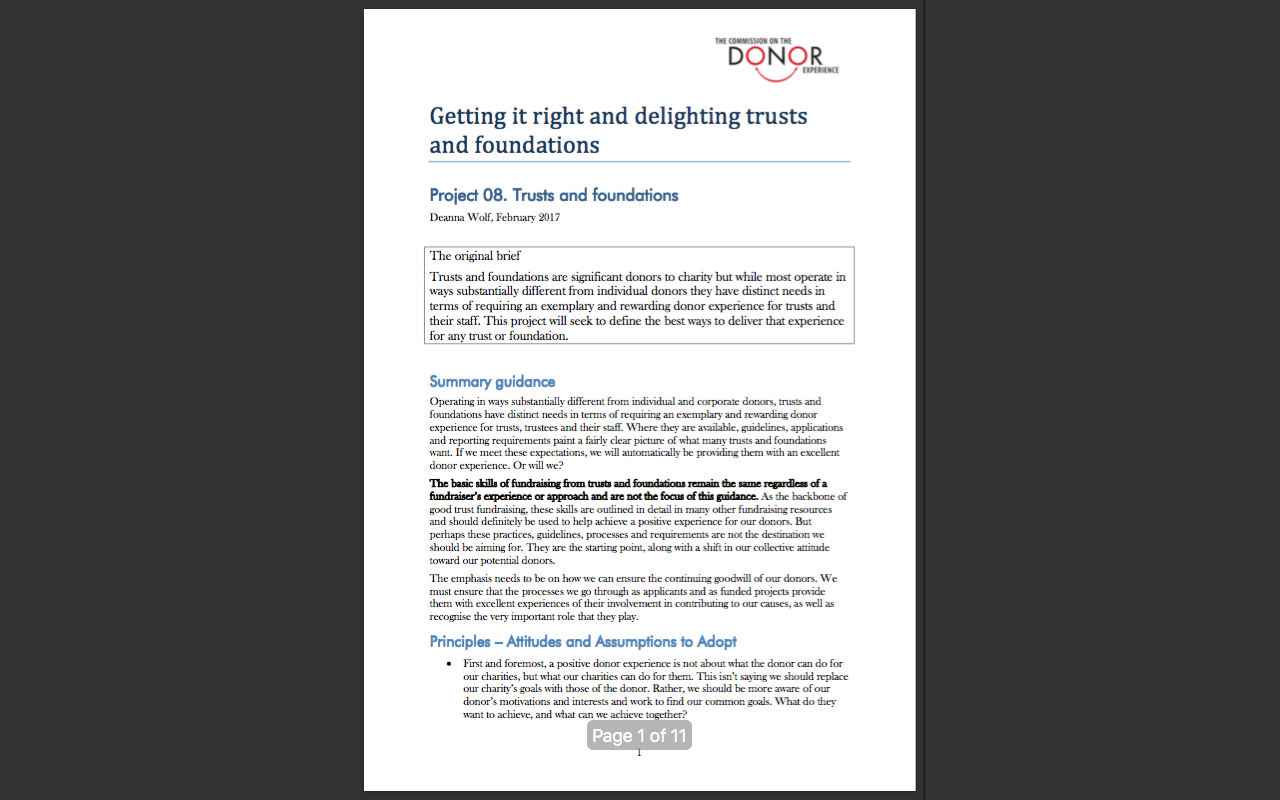CDE project 8 summary: trusts and foundations
- Written by
- The Commission on the Donor Experience
- Added
- May 01, 2017
Getting it right and delighting trusts and foundations
Deanna Wolf, February 2017
Reviewed by: Julie Christie



Summary guidance
Operating in ways substantially different from individual and corporate donors, trusts and foundations have distinct needs in terms of requiring an exemplary and rewarding donor experience for trusts, trustees and their staff. Where they are available, guidelines, applications and reporting requirements paint a fairly clear picture of what many trusts and foundations want. If we meet these expectations, we will automatically be providing them with an excellent donor experience. Or will we?
The basic skills of fundraising from trusts and foundations remain the same regardless of a fundraiser’s experience or approach and are not the focus of this guidance. As the backbone of good trust fundraising, these skills are outlined in detail in many other fundraising resources and should definitely be used to help achieve a positive experience for our donors. But perhaps these practices, guidelines, processes and requirements are not the destination we should be aiming for. They are the starting point, along with a shift in our collective attitude toward our potential donors.
The emphasis needs to be on how we can ensure the continuing goodwill of our donors. We must ensure that the processes we go through as applicants and as funded projects provide them with excellent experiences of their involvement in contributing to our causes, as well as recognise the very important role that they play.
Principles – Attitudes and Assumptions to Adopt
- First and foremost, a positive donor experience is not about what the donor can do for our charities, but what our charities can do for them. This isn’t saying we should replace our charity’s goals with those of the donor. Rather, we should be more aware of our donor’s motivations and interests and work to find our common goals. What do they want to achieve, and what can we achieve together?
- Do your research and find out as much as you can about the trust and its trustees. Who have they funded previously? If your goals are aligned and you approach them, tweak your application – if you are using a base case for support – to the trust. Sometimes even a single sentence will let them know that you were thinking specifically of THEM when you wrote it.
- Do your research and find out as much as you can about the trust and its trustees. Who have they funded previously? If your goals are aligned and you approach them, tweak your application – if you are using a base case for support – to the trust. Sometimes even a single sentence will let them know that you were thinking specifically of THEM when you wrote it.
- Across the country, indeed across the world, there is as much variety in size, composition, purpose, value, and management of trusts and foundations as there is in the charities and organisations which seek their support. There is therefore no single step-by-step approach that will suit all trusts and foundations. Although there are some general similarities in the sector, a case-by-case approach must be taken with each trust or foundation. Do not assume that what works in London will work in the rest of England or in the other Nations. Do not assume that it won’t.
- Use the guidelines, talk to others, and more importantly pick up the phone. Find out what the trust wants and adhere to that. If they want minimal or no communication, respect that. If they want a detailed report, provide that, regardless of their donation size, and without complaint. If they do not say either way, deliver at least a basic report which tells what happened, who benefited and how, and be appropriately grateful. Follow their guidelines on press involvement. Invitations to events or launches may or may not be acknowledged or accepted; in my experience this really is dependent on the community and location within the UK. Abide by their decisions and learn from them for future interaction.
- Trusts and foundations are not nameless, faceless corporate bodies. They are managed by busy people, often themselves volunteers, and are trying to fulfil the vision, wish, dream or passion of their founder and/or their current trustees to do something to make the world a better place. As charities, we can help them realise this goal if our own is in alignment.
- The funds that a trust is giving to you come from the founder; the trustees that control those funds do so with that specific purpose. If your project is too ‘round’ for their ‘square’ guidelines, move on to another funder. If you are in alignment, follow best practice in all aspects of the application and grant management process, deliver on your promises, and remember and accept that whilst your charity may be the expert in delivering services to a particular group that does not excuse your charity’s benevolent or fundraising activities from scrutiny. Be willingly transparent.
- Trusts and foundations do not exist for our convenience. Their only responsibility is to deliver their charitable objects as set out in their governing documents. However, whilst it is not their responsibility to design their processes to meet our requirements or make our lives, as fundraisers, easier or harder, many trusts acknowledge that the relationship they have with applicants is symbiotic and they are trying to make the process if not easier, at least potentially more streamlined (e.g., the work being carried out by the Scottish Funders’ Forum).
- It can be frustrating when a trust’s guidelines or requirements do not easily fall in line with our timetables and financial demands. Nevertheless, do not forget that the trust and its trustees or representatives are as important a part of the fundraising equation as the charity’s beneficiaries – albeit in different ways. Do not let them be sidelined in the quest for money to deliver your charity’s aims and goals. Without them, you will struggle. Finding a range of appropriate and interested funders to cover all aspects of our financial need is our job. Trust fundraising is not rocket science, but no one ever said it would be ea
- Respect and honour the trust or foundation, their staff and volunteers, and their guidelines. NEVER forget that it is not YOUR money
you are spending, it is THEIR donation.
- Never forget that the grant you have been awarded is a gift, not a loan, not a random payment. Be gracious and communicate how it is being used or if there are problems. Regardless of how worthy and necessary the work of your charity, understand that you are one of many such charities. The trust, its trustees and volunteers do not owe you anything.
Practical Donor-Centric Actions – Not Trust Fundraising 101
For most of us, I believe that adjusting our trust fundraising practice to be more donor-centric is largely to do with our attitude rather than significantly altering daily tasks or processes. However, acting to acknowledge and meet the basic elements of these four categories will go a long way toward an excellent donor experience.
- Maintain and improve your own fundraising practice and skills: Trust fundraising is not simply writing and submitting bids. There are many online and literature-based resources available giving trust fundraising basics, tips, and tricks as well as regular courses and conferences. Do your research and take responsibility for your own practice.
- Follow the guidelines provided: If there are no guidelines, concisely and clearly answer the basic questions (where, why, what, when, who, how, and how much).
- Do your research. Make sure you meet their criteria. If you do not meet it, and you do not have a pre-existing relationship or research to the contrary, do not apply.
- Remember that sometimes it is about the relationship and sometimes it is not.
- If in doubt, contact the trust by whatever method possible.
- Submit quality applications for quality projects: Your well-written, accurate application should be on time, as requested and deliverable.
- Recognise that whilst it may be symbiotic, the relationship between trusts and applicants/awardees is unequal. Resist exaggerating needs or methods, or over-extending capabilities, capacity or outcomes in order to secure funding. This can only lead to disappointment and possible reputational damage for everyone involved. Realistically and practically, “under-promise and over-deliver.”
- Engage in effective stewardship and relationship-building: Do not forget to be grateful and be sincere in a timely manner. Follow the trust’s wishes regarding levels of communication and interaction / relationship-building.
- Report back on time, honestly and at a level the trust/trustees will find appropriate
- If suitable, invite trustees and trust staff to see services in action or to a stewardship event. Accept that they may not engage.
- Involve your Chief Executive, key operational staff, and maybe beneficiaries in the relationship you build with the trust.
- If the trust does not want a relationship, respect that.
- Be upfront and proactive if things aren’t working in your funded project.
- If acceptable to the trust, keep in touch between applications and projects.
- Leave an accurate and comprehensive record of the relationship
between your charity and its donors for your successor. Think about what you would want left for you. - Say thank you. Honestly and sincerely. This cannot be re-iterated often enough.



















